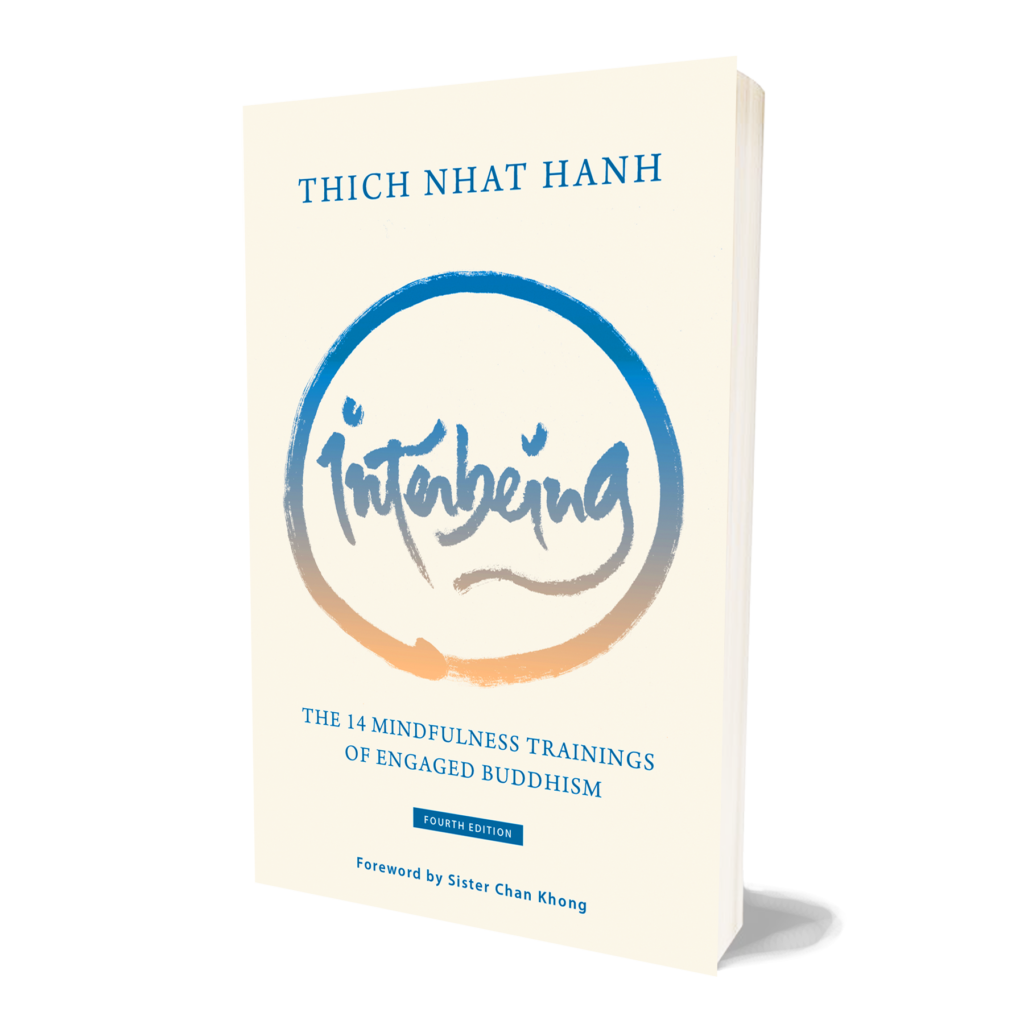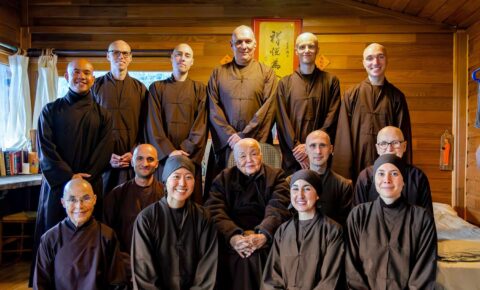In this extract from the newly published 4th edition of Interbeing, Thich Nhat Hanh offers a commentary on the first of the Fourteen Mindfulness Trainings of Engaged Buddhism. This training reminds us to guard against discriminative and dualistic thinking and to avoid becoming bound by any ideology.
The First Mindfulness Training – Openness
Aware of the suffering created by fanaticism and intolerance, we are determined not to be idolatrous about or bound to any doctrine, theory, or ideology, even Buddhist ones. We are committed to seeing the Buddhist teachings as a guiding means that help us learn to look deeply and develop our understanding and compassion. They are not doctrines to fight, kill, or die for. We understand that fanaticism in its many forms is the result of perceiving things in a dualistic or discriminative manner. We will train ourselves to look at everything with openness and the insight of interbeing in order to transform dogmatism and violence in ourselves and the world.
The Fourteen Mindfulness Trainings were born in a sea of fire in 1966 in Vietnam. The situation of the war was extremely hot. And we know how hot the fire of fanaticism can be. That is why the very first precept is about nonattachment to views, openness, and tolerance, because we see that attachment to views, narrowness, and fanaticism is the ground of a lot of suffering. As members of the core or the extended community, we know that we have to learn about and gain the insight of interbeing. We should not be dogmatic, we should not be attached to any kind of ideology or views. That is the basic teaching of the Buddha and that is the first precept of the Order of Interbeing.
The First Mindfulness Training of the Order of Interbeing reveals the openness and tolerance of Buddhism. According to Buddhism, if we do not continue to expand the boundaries of our understanding, we will be unable to go forward on the path of insight.
The Buddha’s teachings are a means of helping people. They are not an end in themselves, they are not something to worship or fight over. Clinging fanatically to an ideology or a doctrine not only prevents us from learning new ways of seeing things, but also creates bloody conflicts. The worst enemies of Buddhism are fanaticism and narrow-mindedness. Religious and ideological wars have marred the landscape of human history for millennia. Holy wars have no place in Buddhism, because killing destroys everything Buddhism stands for. The destruction of lives and moral values during the Vietnam War was very much the fruit of fanaticism and narrowness. The Order of Interbeing was born during a time of utmost suffering, like a lotus flower arising from a sea of fire. Understood in this context, the First Mindfulness Training of the Order of Interbeing is the compassionate voice of the Buddha resonating in an ocean of hatred and violence.

In the spirit of interbeing, each one of the trainings contains all the others. The First Mindfulness Training includes all the others, and all the other trainings contain the first. We can see clearly that the first is the basis of the twelfth training, which urges us to protect all life. In Buddhism, actions are seen to arise in three domains: in body, speech, and mind. We usually think that killing is a physical action and occurs in the domain of the body, but a fanatical mind can cause the killing of not just one, but millions of human beings. If we were to truly follow the guidance of the First Mindfulness Training, all weapons would become obsolete.
The teachings and practices found in Buddhism may vary, but all of them aim at liberating the mind. Openness and nonattachment to views are the guiding principles for all endeavors leading to reconciliation and peace. They are also the doors that lead to the world of ultimate reality and absolute freedom.
The Buddha regarded his own teachings as a raft to cross the river and not as an absolute truth to be worshipped or clung to. Ideological inflexibility is responsible for so much of the conflict and violence in the world. Many Buddhist texts including the Kalama Sutra, the Arittha Sutra (Knowing the Better Way to Catch a Snake), and the Vajracchedika Sutra (The Diamond That Cuts through Illusion), address this important subject.
The first training teaches us to guard against dualistic thinking and discrimination because these attitudes lead to fanaticism, prejudice, and intolerance. When we observe the terrorism and consequent anti-terrorism in the world at this time, we see how both stem from clinging to dualistic ways of seeing others and the world—the idea that “they” are different from “us”—and the failure to see that we interare.
We need to look deeply into the nature of interbeing because all of us have the seeds of discrimination in the depths of our consciousness which need to be transformed. Those of us who practice as members of the core community or the extended community know that we have to transform this tendency of dualistic thinking.
Clinging to views can prevent us from arriving at a deeper, more profound understanding of reality. Buddhism urges us to transcend even our own knowledge if we wish to advance on the Path of Awakening. Views, drishti, are regarded as “obstacles to knowledge.”
Clinging to views can prevent us from arriving at a deeper, more profound understanding of reality.
The First Mindfulness Training of the Order of Interbeing opens us to the total openness and absolute tolerance of Buddhism. Openness and tolerance are not merely ways to deal with people in daily life; they are truly gateways for the realization of the Way. According to Buddhism, if we do not continue to expand the boundaries of our understanding, we will be imprisoned by our views and unable to realize the Way. In our own time, in the fields of politics, sociology, psychology, ethics, and even much of science, as well as in society in general, dualistic thinking is a significant obstacle. Mind and matter are seen as two separate entities that exist independently of each other; the subject of perception (the one perceiving) is seen as being different from the object of perception (that which is being perceived). Particle physicists have now been able to see that the thing observed is not a reality separate from the observer.
The first training highlights the need for us to gain insight into the reality of nonduality, as already outlined in the first of the Five Mindfulness Trainings. With the insight of no separate self, of interbeing, and of the nondualistic nature of all that is, we are able to put an end to discrimination, prejudice, and intolerance.
When we read discourses of the Buddha, we often encounter the expression, “the great roar of the lion,” which is the truth loudly and clearly proclaimed by the Buddha himself or one of his great disciples. The First Mindfulness Training of the Order of Interbeing is one such roar of the lion: the compassionate voice of the Buddha admonishing us not to be caught in any ideology or system of thought whatsoever.
This extract from the newly published 4th edition of Interbeing has been published with kind permission of Parallax Press. Interbeing is available on the Parallax Press website.







Join the conversation